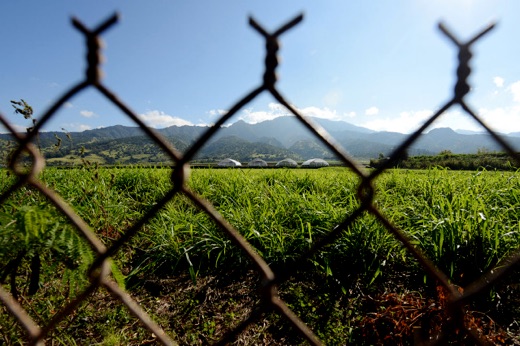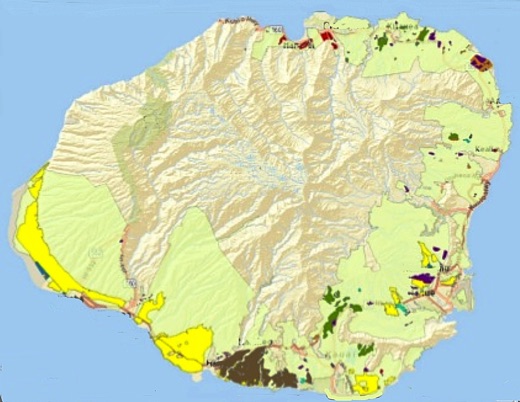SUBHEAD:Government report calls for buffer zones and requirements that GMO companies disclose pesticide use.
By Anita Hofschneider on 9 March 2016 for Civil Beat -
(http://www.civilbeat.com/2016/03/government-study-backs-pesticide-rules-that-lawmakers-keep-rejecting/)

Image above: A view of fields farmed by Pioneer Hi-Bred International Inc. on the North Shore of Oahu. From original article.
[IB Publisher's note: To see full report visit the original article in Civil Beat or visit (http://www.slideshare.net/civilbeat/kauai-pesticides-joint-fact-finding-full-report-draft-3102016)]
Hawaii should dramatically improve its regulation of pesticide use and study its impacts — something the Legislature has repeatedly refused to do — according to a draft version of a report commissioned by the State of Hawaii and Kauai County.
It calls for buffer zones around areas where large amounts of restricted-use pesticides are applied, and requirements that GMO seed companies disclose after the fact what restricted-use pesticides they used, how much, and where.
The study found no statistically significant evidence that pesticide use by large agricultural companies has harmed Kauai’s environment or the health of residents, but says serious data gaps hindered the analysis.
The state Department of Agriculture and the Kauai County Council commissioned the $100,000 report in December 2014 in response to public concerns about the environmental and health impacts of pesticide use by seed companies such as Syngenta and DuPont Pioneer.
Civil Beat obtained a draft version of the report that’s expected to be published Thursday on the project’s website. The study is the product of more than 2,000 hours of research by a diverse group of eight stakeholders led by Peter Adler of consulting firm Accord3.0.
The group included organic farmer Louisa Wooton; Sarah Styan, a senior research manager at DuPont Pioneer; and Gerardo Rojas Garcia, a site manager at another seed company on Kauai, Dow AgroSciences.
The draft report calls upon Gov. David Ige to champion pesticide issues and says the Legislature should “undertake a major update of Hawaii’s pesticide laws and regulation.”
That includes requiring mandatory disclosure of restricted-use-pesticide applications by all large users and implementing a buffer zone policy. Both are policy initiatives consistently pushed by advocacy groups like the Center for Food Safety but rejected by the Legislature as recently as this year.
In a phone interview Wednesday, Center for Food Safety Hawaii’s executive director, Ashley Lukens, said the report’s recommendations are reasonable and reflect the policies that the nonprofit organization has been pursuing for years.
She wasn’t fazed by the fact that the group couldn’t find evidence linking the seed companies’ pesticide use to negative health impacts.
“Of course they’re unable to find evidence that definitely links the pesticide use of these companies to adverse health impacts, because they’re not collecting the pesticide use data or health data, so how could they ever generate those conclusions?” Lukens said.
The report also recommended that seed companies “provide greater public access to their field base maps and the geographic coordinates and identifiers of their pesticide application data in a manner that doesn’t compromise business practices or security.”
“The capability exists to determine how much pesticide application activity occurs at a particular location and at a given time; however it is not currently being done,” the report says. “This information is essential to performing future environmental and health impact studies.”
It’s unclear how open seed companies would be to providing that information. Bennette Misalucha, executive director of the local seed industry’s trade group, issued the following statement through a spokesman in response to a Civil Beat inquiry Wednesday:
• In addition to Garcia, Styan and Wooton, the study group members include Adam Asquith, who holds a doctorate in entomology and works at the University of Hawaii Sea Grant College Program; Lee Evslin, a semi-retired physician; Kathleen West-Hurd, an expert in planning and land use; retired surgeon Douglas Wilmore; and Kawika Winter, director of the Limahuli Garden and Preserve.

Image above: Map of Kauai agriculture. Note light greenish colored area is state designated for agricultural use. The bright yellow area are under operation of GMO seed and pesticide companies. The brown area is the Kauai Coffee plantation. Red is taro fields, purple is diversified truck crops, and green is forestry. From page 18 of report.
.
By Anita Hofschneider on 9 March 2016 for Civil Beat -
(http://www.civilbeat.com/2016/03/government-study-backs-pesticide-rules-that-lawmakers-keep-rejecting/)

Image above: A view of fields farmed by Pioneer Hi-Bred International Inc. on the North Shore of Oahu. From original article.
[IB Publisher's note: To see full report visit the original article in Civil Beat or visit (http://www.slideshare.net/civilbeat/kauai-pesticides-joint-fact-finding-full-report-draft-3102016)]
Hawaii should dramatically improve its regulation of pesticide use and study its impacts — something the Legislature has repeatedly refused to do — according to a draft version of a report commissioned by the State of Hawaii and Kauai County.
It calls for buffer zones around areas where large amounts of restricted-use pesticides are applied, and requirements that GMO seed companies disclose after the fact what restricted-use pesticides they used, how much, and where.
The study found no statistically significant evidence that pesticide use by large agricultural companies has harmed Kauai’s environment or the health of residents, but says serious data gaps hindered the analysis.
The state Department of Agriculture and the Kauai County Council commissioned the $100,000 report in December 2014 in response to public concerns about the environmental and health impacts of pesticide use by seed companies such as Syngenta and DuPont Pioneer.
Civil Beat obtained a draft version of the report that’s expected to be published Thursday on the project’s website. The study is the product of more than 2,000 hours of research by a diverse group of eight stakeholders led by Peter Adler of consulting firm Accord3.0.
The group included organic farmer Louisa Wooton; Sarah Styan, a senior research manager at DuPont Pioneer; and Gerardo Rojas Garcia, a site manager at another seed company on Kauai, Dow AgroSciences.
The draft report calls upon Gov. David Ige to champion pesticide issues and says the Legislature should “undertake a major update of Hawaii’s pesticide laws and regulation.”
That includes requiring mandatory disclosure of restricted-use-pesticide applications by all large users and implementing a buffer zone policy. Both are policy initiatives consistently pushed by advocacy groups like the Center for Food Safety but rejected by the Legislature as recently as this year.
In a phone interview Wednesday, Center for Food Safety Hawaii’s executive director, Ashley Lukens, said the report’s recommendations are reasonable and reflect the policies that the nonprofit organization has been pursuing for years.
She wasn’t fazed by the fact that the group couldn’t find evidence linking the seed companies’ pesticide use to negative health impacts.
“Of course they’re unable to find evidence that definitely links the pesticide use of these companies to adverse health impacts, because they’re not collecting the pesticide use data or health data, so how could they ever generate those conclusions?” Lukens said.
The report also recommended that seed companies “provide greater public access to their field base maps and the geographic coordinates and identifiers of their pesticide application data in a manner that doesn’t compromise business practices or security.”
“The capability exists to determine how much pesticide application activity occurs at a particular location and at a given time; however it is not currently being done,” the report says. “This information is essential to performing future environmental and health impact studies.”
It’s unclear how open seed companies would be to providing that information. Bennette Misalucha, executive director of the local seed industry’s trade group, issued the following statement through a spokesman in response to a Civil Beat inquiry Wednesday:
“The Hawaii Crop Improvement Association thanks the Joint Fact Finding Group for its long months of work. We anticipate that the group’s report will confirm that the industry has been responsible in its use of agricultural products. It would be irresponsible for us to comment on a draft document that is subject to change. Once a final document is officially released, we will be able to respond.”
The draft report’s recommendations include:
- The state should establish new standards of pesticide safety that consider Hawaii’s unique environment and take into account the impacts of chronic exposure.
- The Department of Agriculture should implement a pilot program to monitor pesticide drift and improve current protocols for responding to incidents of pesticide exposure.
- The department should also add a user fee to pesticide sales to fund pesticide monitoring initiatives; add more pesticide inspectors to tackle the agency’s backlog; require that field workers undergo mandatory medical checks for pesticide toxicity; and create an annual monitoring program for bees and honey.
- The Department of Health should implement continuous water monitoring and air, soil and dust sampling programs. The agency should also complete all missing years of data on cancer and birth defects, and start including zip codes in its data collection.
- The Department of Education should pursue an air monitoring program at Kauai schools and offer voluntary blood and urine tests.
- The Department of Land and Natural Resources should start a pilot program to test for pesticides in wildlife and test surface waters in wetland habitats and bird sanctuaries.
- The Office of Hawaiian Affairs should annually monitor the presence of pesticides in salts collected by Native Hawaiian practitioners.
• In addition to Garcia, Styan and Wooton, the study group members include Adam Asquith, who holds a doctorate in entomology and works at the University of Hawaii Sea Grant College Program; Lee Evslin, a semi-retired physician; Kathleen West-Hurd, an expert in planning and land use; retired surgeon Douglas Wilmore; and Kawika Winter, director of the Limahuli Garden and Preserve.

Image above: Map of Kauai agriculture. Note light greenish colored area is state designated for agricultural use. The bright yellow area are under operation of GMO seed and pesticide companies. The brown area is the Kauai Coffee plantation. Red is taro fields, purple is diversified truck crops, and green is forestry. From page 18 of report.
.
No comments :
Post a Comment